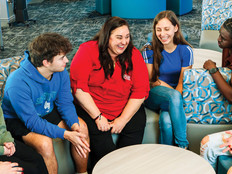1. Emphasize Positive Relationships Between Students and Teachers
This goes back to Maslow’s hierarchy of needs. Students can’t engage in meaningful learning without building positive relationships with their teachers, which may take extra time and effort in a remote setting.
2. Don’t Replicate the Classroom — Reinvent It with a Technology Focus
Different modes of teaching call for different strategies. Supervised labs and hands-on lessons may be replaced by videos, presentations and other materials that allow students to learn at their own pace.
3. Communicate Consistently to Spark Student and Family Engagement
Routine communication will increase student and family engagement. Simply letting families know that you’ll be sending an email each Monday morning with the week’s schedule and assignments — and then following through — can go a long way.
4. Consolidate Tech Tools to Alleviate Stress
Less is often more. If students are asked to use more than three to five tech solutions, they will quickly become overwhelmed. Choose up to five ed tech tools for the remote classroom and stagger implementation to reduce stress for students.
DISCOVER: Which tech takes the top spots for school districts?
5. Teach Digital Citizenship
In a remote learning environment, it’s even more important to cover topics such as finding credible news, responding to online hate speech and dealing with digital drama. Common Sense Education offers a digital citizen curriculum to help educators overcome distance and hybrid learning obstacles. It’s critical to establish a culture of digital citizenship in the classroom to help students safely navigate the digital landscape.
READ MORE: How K–12 schools are expanding tech support along with remote learning.











